Are white wines from Germany sweet? The short answer is, they used to be. Germany is known for its Riesling, a mineral-driven and high acidity white wine with characteristic fruit notes that can range from green and golden apple, to peach, nectarine and other stone fruits. Rieslings can be made in different styles. They might be on the sweeter side or they can be dry.
The main style of Riesling used to be off-dry sweet and because of this many people associate Germany with sweet wines. Off-dry means a wine has a sugar level of 17-25 grams per liter. For comparison, a very dry wine will have less than 1 gram, a dry wine up to 15, and a sweet wine 35-120 grams of sugar per liter.
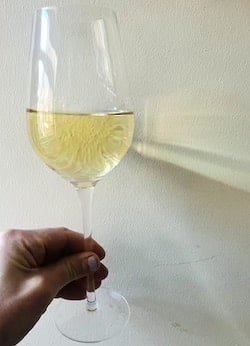
The United States also has a long history of importing sweet German wines. In the 1970s, it wasn’t uncommon to see bottles of Blue Nun and Black Tower on American shelves. These wines are called Liebfraumilch and are a sweet blend of several German grape varieties, mainly Müller-Thurgau and Silvaner.
Nonetheless, things have changed significantly since then. Germany does still make sweet and dessert-level wines, but over a third of their white wines are now markedly dry.
A dry German wine will have the word “Trocken” written on its label. Trocken wines can have up to 9 grams of sugar per liter. If you’ve not tried this style of German Riesling, it is exceptional. The high acidity and tangy fruit flavors make it “perfect drinking” for those who seek bone dry and somewhat austere white wine. It also pairs well with almost every food. Note, you can find Spätlese Trocken as well which is a richer and fuller wine that’s still completely dry.
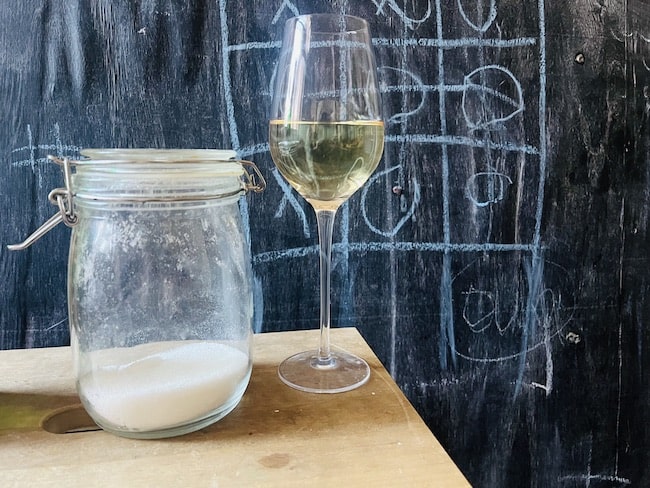
What makes a wine sweet?
The longer grapes stay in the sun, the more sugars they produce. When they’re harvested and pressed, these sugars go into the juice and during fermentation are converted into alcohol. However, not all wines are sweet. How sweet a wine is depends on when the fermentation process is stopped. If you started the winemaking process with grapes that had a higher sugar content to begin with, there can be a lot of residual sugar. This leads to a greater level of sweetness. For example, a dessert wine such as an Auslese may have more than 120 grams of sugar per liter.
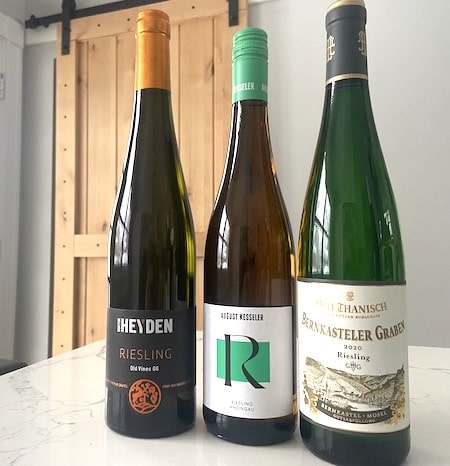
German wines are changing
In recent years, global warming has allowed German winemakers to harvest more fully-ripened grapes and produce white wines with the same fruit flavors, but less sugar. The grapes no longer need to be left on the vine longer to fully ripen. They can be picked sooner, which often results in drier wine. Just keep in mind, sometimes a dry German wine has so much fruit to it people still think it’s sweet!
Another difference is the German winemakers themselves. They are a younger generation who came onto the scene in the early 2000s, went abroad, studied viticulture, and realized trends are changing and the world market was looking for drier wines.
Lastly, the local wine boards who govern German wine production have begun placing more emphasis on quality vs. quantity by reducing allowable yields to a third of what they were before. A vine that formerly held 22 bunches could go down to only eight or ten, or 1.5 bottles per vine! Add to this the popularity of organic and biodynamic farming and you have a wine industry that’s completely reinventing itself.

4 German wine growing regions
There are actually 12 German wine growing regions or appellations, but these are the four you’ll hear the most about:
- Mosel. This region runs alongside the Mosel River and produces some of Germany’s highest-acid and driest Rieslings.
- The Rheingau. The Rhine River is divided into three separate growing areas and the Rheingau contains some of Germany’s most famous vineyards.
- The Rheinhessen. This is Germany’s largest growing area and has become a leader in innovation in grape growing as well as a major producer of Pinot Noir.
- The Rheinpfalz. Also commonly known as Pfalz, this area in western Germany runs north to south bordering both the Rheinhessen and the French province of Alsace.

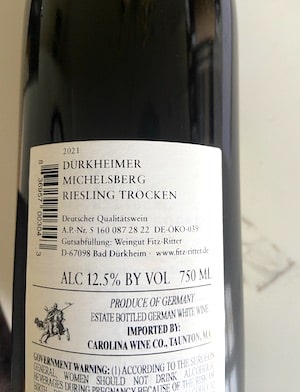
Traditional German wine quality classifications
- QbA stands for Qualitätswein bestimmter Anbaugebiete and is an entry-level, everyday wine.
- Kabinett is usually made from grapes from specific sites that are left on the vine longer. The wine can be fruity and off-dry or on the drier side depending on when the fermentation was stopped. It often reflects the specific terroir and can show elegance and delicacy.
- Spätlese means “late-picked.” Grapes are left on the vine longer so they are sweeter and can ferment to fuller-bodied wines. The alcohol content on the label will tell you how sweet the wine is. If it’s less than 12% it will not have much residual sweetness and 13% will be very dry.
- Auslese translates to “select-picked” and is when hand-selected bunches are chosen from a later picking time. The berries tend to be riper with distinct sweetness and they make a rich, sweet wine.
- Beerenauslese means ”select berry” and is when German winemakers separate the often dried, richer berries from the bunches. These vines might also have been affected by Noble Rot or Botrytis which gives the wine a honeyed sweetness. The result is a rich, lush and sweet dessert wine that is also very expensive. Beerenauslese wines are only made in great vintage years.
- Trockenbeerenauslese are “dried select-picked berries” which are typically affected by Noble Rot. Botrytis effectively dehydrates them so they look like raisins. The result is a highly concentrated dessert wine with an almost endless maturing potential (if produced from Riesling). It takes a large amount to make a bottle and that’s partly why this is the most expensive and richest German dessert wine. It’s only produced during exceptional vintage years.
- Eiswein means “ice wine” and is when the grapes are allowed to stay on the vine until the weather gets cold, below -8C/19F, and freezes them off. The freezing separates the water content from the sugars, which are used to make a sweet dessert-level wine. Nonetheless, these days climate change has made it almost impossible to produce German Eiswein. It stays too warm after the main harvest and the grapes rot away before it gets cold.
Note, while the traditional system is still used for making sweet German wines, the modern system, used by members of the VDP association, or Verband Deutscher Prädikatsweingüter, is somewhat different.

VDP classifications
VDP recognizes Trocken wines as those which best reflect the greatness of specific terroirs. As such, it focuses on the quality-level of the vineyards themselves.
- Grosse Lage is a Grand Cru or the highest classification. It can also be indicated with the letters GG or Great Growth.
- Erste Lage is the next tier down and is akin to Premier Cru.
- Ortswein means village wine.
- Gutswein is an entry-level estate wine without vineyard designation. It is the lowest tier in terms of quality.
The biggest takeaway is the word Trocken. This designates wines that are made in a drier style and have less sweetness to them. You can also find a Spätlese Trocken which means the wine is made from late-picked bunches that were vinified in a drier style. Note, alcohol naturally contains 10% glycerine (a higher form of alcohol which tastes sweet), so if the alcohol level on the label is above 13.5%, it can suggest the wine will have a slight sweetness to it.
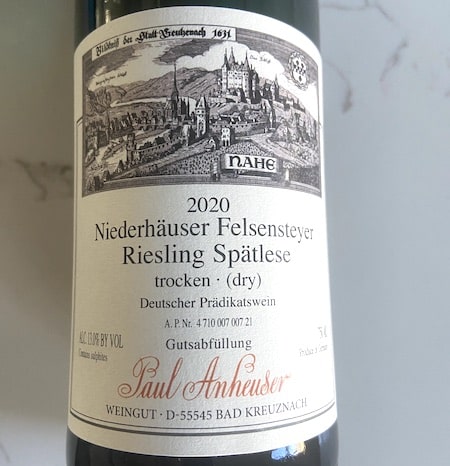
Decoding German wine labels
German wines can be hard to understand from just looking at the label. That’s because, in addition to the kind of grape and year, there’s a lot of additional information listed and it’s not always clear what it all means. The first thing to look for after the grape name is either a VDP or traditional classification term representing the quality of the vineyard or when the grapes were picked. You should also look for the winemaker’s name. In Germany, much like in Burgundy, France, there are numerous single-vineyards owned by multiple wineries. Production is small so you may have 15 different owners in a single area, each with their own five rows of vines. Because of this small scale, you’ll typically find both the name of the winemaker and the name of the vineyard listed on the label, alongside the year.
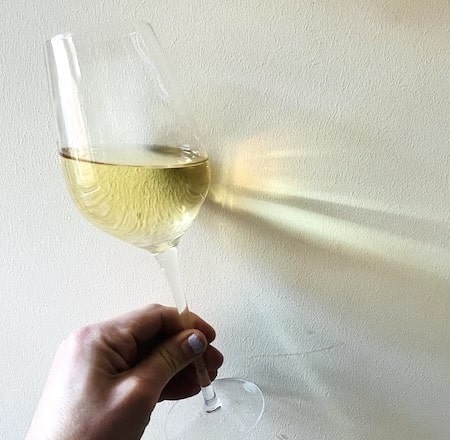
More on Riesling
The Riesling grape does particularly well in Germany because it needs a cold climate to help it achieve a balance of acidity and fruitiness. While it’s a wine that was traditionally known for its sweetness, things have changed. Moreover, the drier Riesling trend isn’t limited to Germany. You can also find some delicious and bone-dry Rieslings from the Alsace region of France. Keep an eye out for Riesling from the Clare and Eden Valley of Australia as well, and even Upper State New York and Washington State in the United States.
Food wine pairings for German wines
Riesling is one of the most versatile wines in the world and can go with virtually every food, from hors d’oeuvres to meat dishes and even desserts. Off-dry and sweet Rieslings at the Auslese level make excellent pairings with soft cheeses. You can serve these wines with goat cheese or even a saltier cheese like feta or gorgonzola (have them with blue cheese too!) For sweeter wines, Beerenauslese and Trockenbeerenauslese are just right for a fruit cobbler or a rich chocolate torte. However, where Riesling really shines is when it’s made in the drier style and served alongside raw shellfish. Riesling is an elegant and natural choice for serving with oysters. It’s one of the best wines to have with sushi and Asian food of all types. It can cut through food that has some spice to it and also has enough fruit to complement white meats like chicken, pork and veal.
Why do some dry wines still taste sweet?

Some people taste a dry wine and think it’s sweet. Technically, it’s the sugar levels of a wine that determine if it’s sweet. Nonetheless, perception plays a big part in how our brains assess sweetness. When we’re tasting a wine, we often talk about its fruit flavors. A wine that’s quite fruity with a lot of up front and rounded flavors (think ripe melon) can trick us into thinking what we’re drinking is sweeter than it really is. Take for example a dry Riesling with ripe golden apple flavors. The fruity notes convince you the wine is sweet when it’s really just the apple you’re tasting. If this sometimes happens to you, try to focus on the finish of the wine instead. If you pick up on good acidity and freshness at the end, you’ll know the wine is actually dry.
Are there German red wines?
Fifty years ago only 17% of German vines were red grapes. Today, just over 30% of all vineyards are being planted with Pinot Noir. Pinot Noir needs to be grown in a cooler climate and likes slate and limestone soils, which are typical of the German wine region. Before climate change, it wasn’t quite warm enough for wines like Pinot Noir to be successful in German vineyards, but today they are the 3rd largest producer in the world! Expect to hear a lot more about German Pinot Noirs in the years to come.

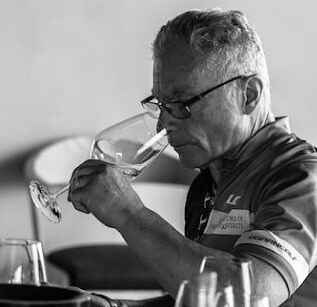
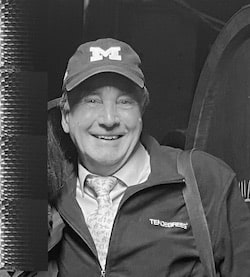



Interesting–the Pinot Noir! How is it? If they’ll be planting more, than can we expect to see it in the US?
It’s good! It’s in the US now and you can usually get a bottle of German Pinot Noir for anywhere from $20 to $50.